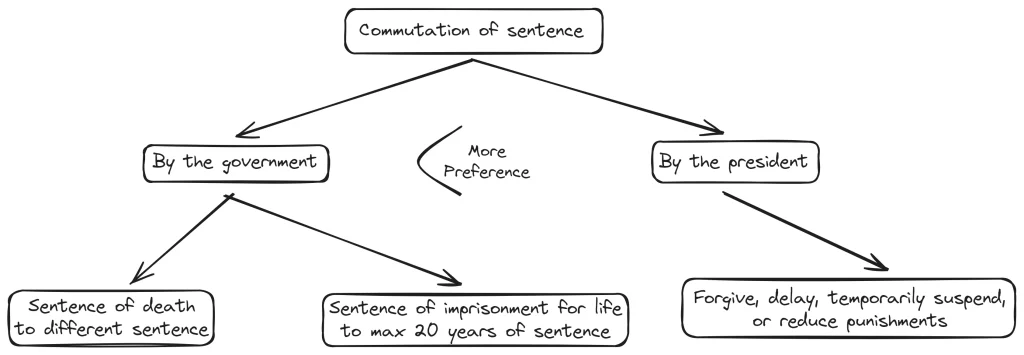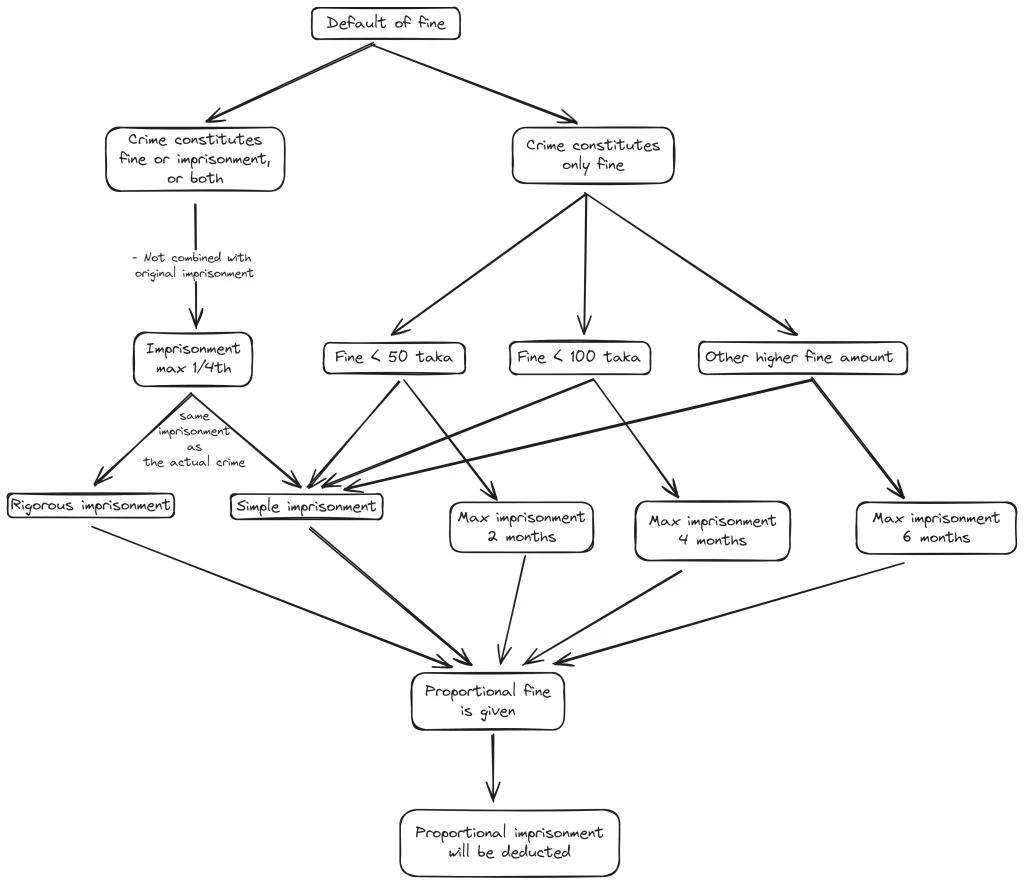
Section (53+57+60+63) [Classification of punishment]
Section 53 (Punishments)
- Death penalty.
- Life imprisonment.
- Imprisonment for life means life in prison until death, no fixed period.
- Only rigorous imprisonment.
- Imprisonment
- Types of imprisonment:
- Rigorous imprisonment.
- Imprisonment with hard labor like working in jail workshops.
- Simple imprisonment.
- Imprisonment without hard labor, prisoner just stays in jail.
- Rigorous imprisonment.
- Types of imprisonment:
- Forfeiture of property.
- Property or assets of the offender can be confiscated by the government.
- Fine.
- Offender may have to pay a financial penalty along with or instead of imprisonment.
Section 57 (Fractions of terms of punishment)
The law treats “imprisonment for life” as the same as thirty years in prison, when courts need to divide or calculate part of a full life imprisonment into years.
Example
Let’s imagine a scenario. John committed a serious crime. The court found him guilty. Normally for this crime, the punishment would be “imprisonment for life”. But because John helped the police catch another criminal, the judge decided to give John a reduced punishment. The judge said John will get only half the normal punishment for this crime. Now, the normal punishment is “imprisonment for life”. But according to the law, “imprisonment for life” is equal to 30 years in prison. So half of “imprisonment for life” means half of 30 years. Half of 30 years is 15 years. Therefore, the judge sentenced John to “rigorous imprisonment for 15 years”.
So in this example, by getting half the punishment of “imprisonment for life”, John was given 15 years in prison. This shows how the law considers “imprisonment for life” the same as 30 years, to make it easy for courts to calculate fractions or parts of a full life sentence.
Section 60 (Sentence may be in certain cases of imprisonment, wholly or partly rigorous or simple)
The court can choose one of three options for the imprisonment:
- Wholly rigorous imprisonment.
- Wholly simple imprisonment.
- Partly rigorous, partly simple.
Section 63 (Amount of fine)
When a law or rule says you can get fined, but it does not give an exact number for how much the fine could be, then the fine amount is not limited.
However, the fine also cannot be too much or excessive. Even though there is no number listed for the maximum fine, the authorities cannot make you pay any amount they want. The fine has to be reasonable.
💡 No fixed fine stated = reasonable fine.
Diagram
![Section (53+57+60+63) [Classification of punishment]](https://sakib.com.bd/wp-content/uploads/2024/06/Section-53576063-Classification-of-punishment-1024x353.webp)
Section 53A (Construction of reference to transportation)
(1) According to the rules stated in subsection (2), whenever you come across the phrase “transportation for life” in any other law that is currently in effect, you should understand it as meaning “imprisonment for life.” In other words, these two phrases can be considered the same.
(2) Similarly, if you encounter the term “transportation” for a specific period of time or a shorter term (no matter what it’s called) in any other law that is currently in effect, you should assume that it has been removed or excluded. This means that the term “transportation” for a shorter duration is no longer applicable or valid.
(3) Now, when you see the term “transportation” in any other law that is currently in effect, you need to consider the following:
(a) If the expression “transportation” means “transportation for life,” you should understand it as “imprisonment for life.” In simple terms, these two phrases have the same meaning.
(b) If the expression “transportation” means “transportation for any shorter term,” you should consider it as if it has been removed or excluded. This means that the term “transportation” for a shorter duration is no longer applicable or valid.
In summary, this passage explains how the term “transportation” is interpreted in different laws. It clarifies that “transportation for life” is the same as “imprisonment for life” and that the term “transportation” for a shorter duration is no longer valid.
- Transportation for life = Imprisonment for life.
- Transportation for any shorter term = Omitted.
Section (54+55+55A) [Commutation]
Section 54 (Commutation of sentence of death)
Whenever a death sentence is issued, the Government can change the punishment to a different punishment listed in the law, without needing the offender’s consent.
Section 55 (Commutation of sentence of imprisonment for life)
Whenever a person is sentenced to life imprisonment, the government has the power to reduce the punishment to a maximum of twenty years in prison without needing the offender’s consent.
Example
Imagine a person named John committed a serious crime, and the court sentenced him to life imprisonment, which means he would have to stay in prison for the rest of his life. However, according to the law, the Government has the power to change this punishment without asking for John’s permission. Now, let’s say the Government decides to commute John’s punishment.
Instead of spending his entire life in prison, they change it to a different type of imprisonment, but with a fixed duration. They decide that John will now serve a prison term of, let’s say, fifteen years. This means that John will stay in prison for fifteen years, and after that, he will be released.
Section 55A (Saving for President’s prerogative)
Section 54 and section 55 do not take away or diminish the President’s authority to forgive, delay, temporarily suspend, or reduce punishments.
Diagram

Section (64+65+66+67+69) [Default of fine]
Section 64 (Sentence of imprisonment for non-payment of fine)
For any crime where the punishment could be either a fine or imprisonment, or both, if the court decides to give only a fine as the sentence, then the court can also do one more thing.
The court can say in the sentence itself that if the offender (person committing the crime) does not pay the fine, then they will have to go to jail for a specific period of time.
This jail term for not paying the fine will be extra or additional compared to any other jail time given for the crime itself. It will also be extra compared to any reduced jail time the offender may get if the original sentence is reduced/commuted in the future.
- No fine = imprisonment
- The imprisonment will be counted as extra, not combined with original imprisonment.**
Section 65 (Limit to imprisonment for non-payment of fine, when imprisonment and fine awardable)
The extra jail time given for non-payment of fine cannot be more than one-fourth (25%) of the maximum regular jail term set for that crime.
Section 66 (Description of imprisonment for non-payment of fine)
The type of imprisonment given for not paying the fine can be the same as the type of imprisonment the offender could have received for the actual crime.
Example
For example, if the crime could be punished by:
• 1 year in regular jail or
• 6 months in community service jail
Then if the court orders a fine + jail if not paid, the jail term given for non-payment can be:
• 1 year in regular jail or
• 6 months in community service jail
Section 67 (Imprisonment for non-payment of fine, when offence punishable with fine only)
This section is talking about the imprisonment given for non-payment of fine, in cases where the crime is only punishable by a fine and no regular jail time.
It states that in such cases, the imprisonment for non-payment will be “simple” imprisonment. Simple imprisonment means basic imprisonment without hard labor.
It then defines limits on how long this simple imprisonment can be for different amounts of fines:
- If the fine is less than 50 taka (currency):
- Maximum imprisonment for non-payment is 2 months
- If the fine is less than 100 taka:
- Maximum imprisonment is 4 months
- For any other higher fine amount:
- Maximum imprisonment is 6 months
Section 69 (Termination of imprisonment on payment of proportional part of fine)
- If someone is unable to pay a fine and is sentenced to imprisonment instead. It states that if, before the end of the imprisonment term, a certain proportion of the fine is paid or collected, the imprisonment will be stopped.
- For example, if the fine is 100 taka and jail time is 4 months:
- If 75 taka is paid after 1 month in jail, the person can be released after 1 month.
- Because 1 month served is proportional to the 25 taka remaining (25/100 = 1/4).
- If 75 taka is paid exactly when the 1 month ends, or any time after, the person can be released immediately.
- If 50 taka is paid before 2 months, the person can be released after 2 full months.
- Because 2 months served is proportional to the 50 taka remaining (50/100 = 1/2).
- If 50 taka is paid exactly when the 2 months end, or any time after, the person can be released immediately.
Diagram

Section (73+74) [Solitary confinement]
Section 73 (Solitary confinement1)
When a person is found guilty of a crime, the court can give them imprisonment. For serious crimes, the court can order rigorous imprisonment.
Along with the jail term, the court has the power to order solitary confinement for some time.
The maximum time for which solitary confinement can be ordered is 3 months total. Here are the rules for how long solitary confinement can be:
- If the jail term is less than 6 months, solitary confinement cannot be more than 1 month.
- If the jail term is more than 6 months but less than 1 year, solitary confinement cannot be more than 2 months.
- If the jail term is more than 1-year, solitary confinement cannot be more than 3 months.
Table
| Imprisonment Given | Solitary confinement |
|---|---|
| Less than 6 months | Max 1 month |
| 6 months – 1 year | Max 2 month |
| More than 1-year | Max 3 month |
Section 74 (Limit of solitary confinement)
- Each period of solitary confinement cannot be more than 14 days continuously.
- After 14 days in solitary confinement, the person must be kept outside solitary confinement for at least 14 days.
- If the total imprisonment sentence is more than 3 months, solitary confinement periods cannot be more than 7 days in any single month.
- When in solitary confinement for 7 days in a month, the person must spend at least the next 7 days outside solitary confinement, before solitary confinement can resume.
Diagram of combination for section (53+57+60+63+64+65+66+67+69)
https://drive.google.com/file/d/1scTfvfQmzgNPGNJnoqsj0XA2BQnmg4gb/view?usp=sharing- Solitary confinement means keeping the convicted person alone in a cell, away from other prisoners. ↩︎






